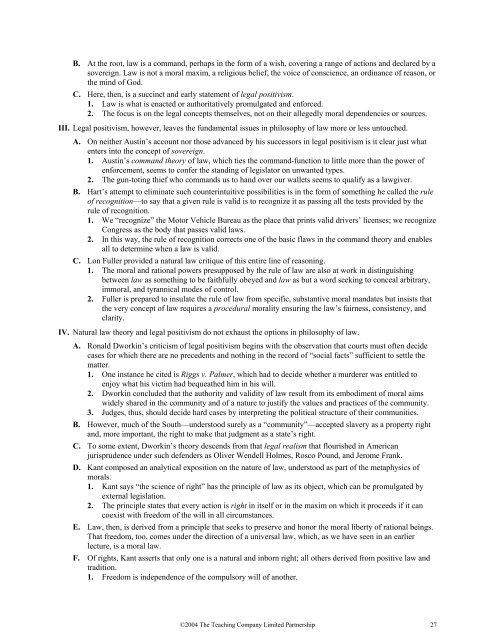Great Ideas of Philosophy
Great Ideas of Philosophy
Great Ideas of Philosophy
- No tags were found...
Create successful ePaper yourself
Turn your PDF publications into a flip-book with our unique Google optimized e-Paper software.
B. At the root, law is a command, perhaps in the form <strong>of</strong> a wish, covering a range <strong>of</strong> actions and declared by asovereign. Law is not a moral maxim, a religious belief, the voice <strong>of</strong> conscience, an ordinance <strong>of</strong> reason, orthe mind <strong>of</strong> God.C. Here, then, is a succinct and early statement <strong>of</strong> legal positivism.1. Law is what is enacted or authoritatively promulgated and enforced.2. The focus is on the legal concepts themselves, not on their allegedly moral dependencies or sources.III. Legal positivism, however, leaves the fundamental issues in philosophy <strong>of</strong> law more or less untouched.A. On neither Austin’s account nor those advanced by his successors in legal positivism is it clear just whatenters into the concept <strong>of</strong> sovereign.1. Austin’s command theory <strong>of</strong> law, which ties the command-function to little more than the power <strong>of</strong>enforcement, seems to confer the standing <strong>of</strong> legislator on unwanted types.2. The gun-toting thief who commands us to hand over our wallets seems to qualify as a lawgiver.B. Hart’s attempt to eliminate such counterintuitive possibilities is in the form <strong>of</strong> something he called the rule<strong>of</strong> recognition—to say that a given rule is valid is to recognize it as passing all the tests provided by therule <strong>of</strong> recognition.1. We “recognize” the Motor Vehicle Bureau as the place that prints valid drivers’ licenses; we recognizeCongress as the body that passes valid laws.2. In this way, the rule <strong>of</strong> recognition corrects one <strong>of</strong> the basic flaws in the command theory and enablesall to determine when a law is valid.C. Lon Fuller provided a natural law critique <strong>of</strong> this entire line <strong>of</strong> reasoning.1. The moral and rational powers presupposed by the rule <strong>of</strong> law are also at work in distinguishingbetween law as something to be faithfully obeyed and law as but a word seeking to conceal arbitrary,immoral, and tyrannical modes <strong>of</strong> control.2. Fuller is prepared to insulate the rule <strong>of</strong> law from specific, substantive moral mandates but insists thatthe very concept <strong>of</strong> law requires a procedural morality ensuring the law’s fairness, consistency, andclarity.IV. Natural law theory and legal positivism do not exhaust the options in philosophy <strong>of</strong> law.A. Ronald Dworkin’s criticism <strong>of</strong> legal positivism begins with the observation that courts must <strong>of</strong>ten decidecases for which there are no precedents and nothing in the record <strong>of</strong> “social facts” sufficient to settle thematter.1. One instance he cited is Riggs v. Palmer, which had to decide whether a murderer was entitled toenjoy what his victim had bequeathed him in his will.2. Dworkin concluded that the authority and validity <strong>of</strong> law result from its embodiment <strong>of</strong> moral aimswidely shared in the community and <strong>of</strong> a nature to justify the values and practices <strong>of</strong> the community.3. Judges, thus, should decide hard cases by interpreting the political structure <strong>of</strong> their communities.B. However, much <strong>of</strong> the South—understood surely as a “community”—accepted slavery as a property rightand, more important, the right to make that judgment as a state’s right.C. To some extent, Dworkin’s theory descends from that legal realism that flourished in Americanjurisprudence under such defenders as Oliver Wendell Holmes, Rosco Pound, and Jerome Frank.D. Kant composed an analytical exposition on the nature <strong>of</strong> law, understood as part <strong>of</strong> the metaphysics <strong>of</strong>morals.1. Kant says “the science <strong>of</strong> right” has the principle <strong>of</strong> law as its object, which can be promulgated byexternal legislation.2. The principle states that every action is right in itself or in the maxim on which it proceeds if it cancoexist with freedom <strong>of</strong> the will in all circumstances.E. Law, then, is derived from a principle that seeks to preserve and honor the moral liberty <strong>of</strong> rational beings.That freedom, too, comes under the direction <strong>of</strong> a universal law, which, as we have seen in an earlierlecture, is a moral law.F. Of rights, Kant asserts that only one is a natural and inborn right; all others derived from positive law andtradition.1. Freedom is independence <strong>of</strong> the compulsory will <strong>of</strong> another.©2004 The Teaching Company Limited Partnership 27














